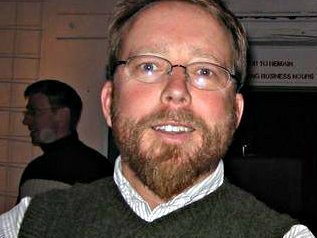Dr. Eduardo de Cruz points to infection rate statistics posted at Children's Hospital.
A new study says that one in three American hospital patients are injured by a medical error during their stay. The federal government is rolling out a one billion dollar initiative to substantially reduce medical mistakes. Colorado hospitals have lots of questions. Colorado Public Radio Health Reporter Eric Whitney has more.
Whitney: In the cardiac intensive care unit at Children's Hospital in Denver, Daniel and Theresa Meza sit by the bed of their sleeping 2-year-old son. Two days earlier, they sent him in to surgery to fix a congenital heart defect.
THERESA: It's an overwhelming feeling, I think, as parents, to be able to trust a complete stranger, and trust that they are going to do a good job with your child and that things are going to come out OK in the end.
WHITNEY: Too often, that trust is betrayed. So says Dr. Mark Levine. He's with the federal Center for Medicaid and Medicare Services, which pays for a big chunk of health care in America. It’s estimated that medical mistakes cost the health system overall 17 billion dollars a year.
LEVINE: (over PA) that's unacceptable and we must do better.
WHITNEY: Levine was speaking at a press conference at Children's Thursday (4.21.11). touting the local role in the the White House's new hospital safety initiative, the “Partnership for Patients.”
LAVINE: (over PA) we have pledged to reduce preventable injuries by 40% in American hospitals, thus preventing 1.8 million injuries, and saving 60,000 lives, a fair-sized city, 60,000 lives.
WHITNEY: The pledge comes with a billion dollars to help change hospital practices nationally. Part of it will be spent trying to duplicate local programs that have worked to reduce medical errors. Hospitals can apply for grants to do things like change treatment protocols, train staff and buy computer systems that can help prevent mistakes.
Is a billion dollars enough to cut errors by 40%? Dr. Dan Hyman, the chief quality officer at Children's says no.
HYMAN: Oh, it's extremely expensive. It is a huge investment to do this work. But at the end, we really do believe that providing safer, more effective care will also be more efficient, and we will ultimately reduce costs by doing this kind of work.
WHITNEY: But Denver Patient Safety Advocate Kerry O'Connel says money isn’t necessarily the barrier to improving safety. He says there are already well-known, effective strategies that hospitals could be using now. The trick is getting hospital leaders push hard to put them in place.
O'Connell thinks those leaders need some personal financial incentives.
O’CONNELL: you don't really need 500 million to tie performance measures to leaders' bonuses. You can do that for next to nothing.
WHITNEY: The federal plan to reduce hospital mistakes includes tying hospital payments to their error rates. O’Connel says if he could spend the federal money, he’d make it mandatory for hospitals to report all their safety problems. At present reporting requirements vary widely from state to state. And he’d like to make sure hospital staff actually do what they’re supposed to to prevent mistakes.
O’CONNELL: might even go into putting in surveillance in hospitals, with cameras in video in ORs, to record what goes on, and hold people accountable when they don’t follow the known procedures.
WHITNEY: No one knows whether the new federal initiative will pay for things like surveillance cameras in operating rooms. A lot of specifics aren’t yet spelled out. Still Steven Summer, head of the Colorado Hospital Association says he group is eager to learn more.
SUMMER: there are some questions in terms of how what we heard today actually manifests itself into specific programs and activities at the local level.
WHITNEY: A few Colorado hospitals have already been cited by federal health officials as examples of excellent care that should be shared nationwide. Summer says he hopes part of the federal money will help all the state’s hospitals get together to learn from one another.









